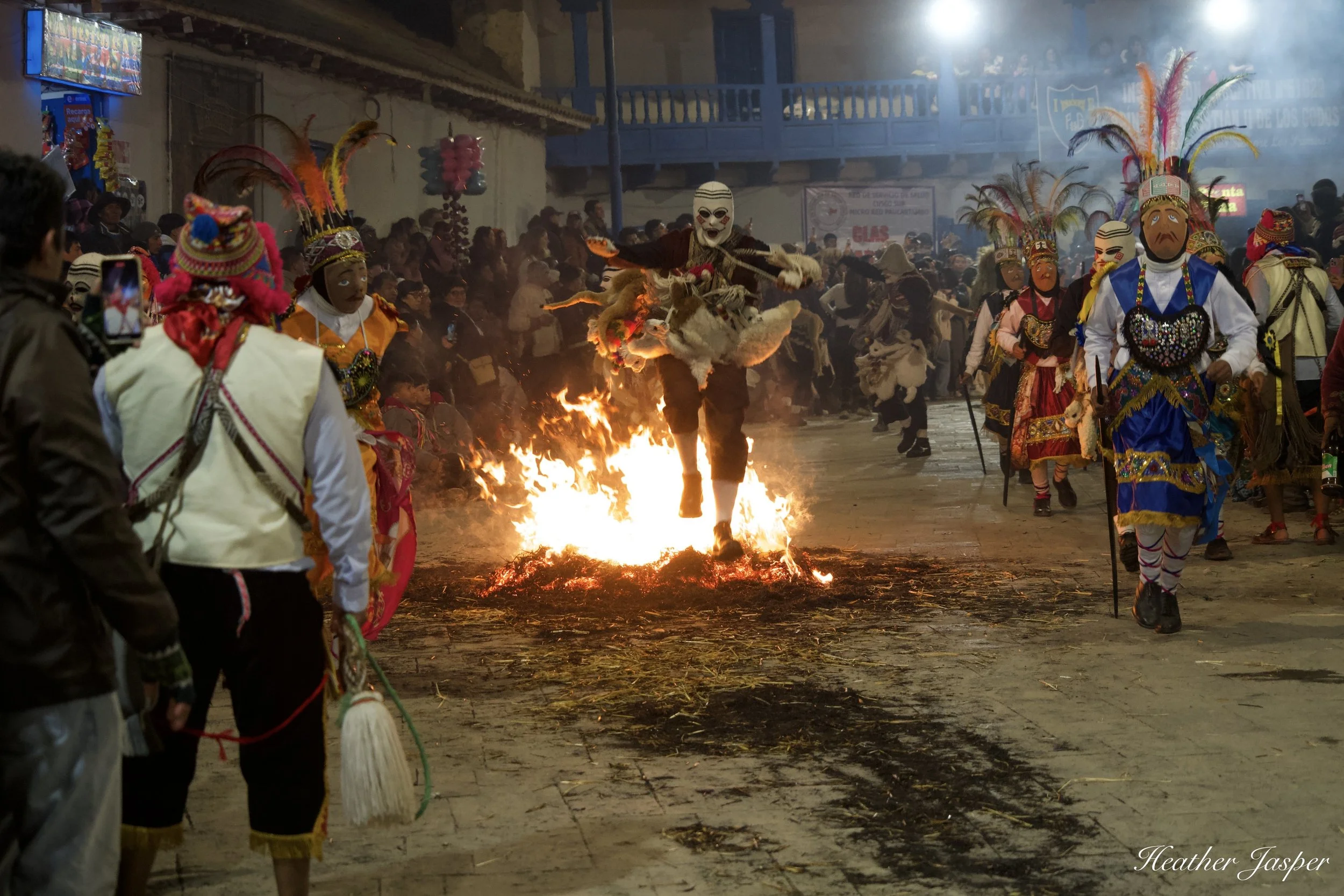Paucartambo 2024
The Virgin of Carmen is carried around Paucartambo’s plaza while the Saqras threaten her from above.
The festival for the Virgin of Carmen in Paucartambo is a truly overwhelming experience.
It’s four full days of dance, music, a little singing and a lot of Catholic tradition.
This was my second year following the Saqras throughout the festival and I’m thrilled to announce that their story will be published by Ori Magazine later this year! Read about my time with the Saqra last year in my 2023 blog.
The festival is July 15-18th every year, but this year I went a day early to see how the Saqras prepare. Below is a brief itinerary of the traditions I witnessed each day.
Killing the bull
July 14 the Saqras gather at the river to slaughter a young bull. They bless it with pisco and port, thanking it for giving them the strength to dance for 4 days. Every part of the bull was eaten.
July 15
The morning that the festival begins, the Saqras always get dressed in their costumes, trajes in Spanish, on a hill above town. They admire each others’ new masks and trajes, which most Saqras embroider themselves, and the singing begins. It’s an important reunion. Most have seen each other over the past month or so at dance practice on weekends, but a few work far enough away that they can’t come to Paucartambo until the week of the festival. One Saqra, who works in northern Peru, told me that the festival for the Virgin of Carmen is the only time he really sees his family.
El Caporal
The Caporal, Marco Palacio Concha, is the Saqras’ elected leader. He oversees every aspect of their performance, ensuring they follow tradition and live up to the standards of the danza.
La China
The only woman to dance with the Saqras is called the China Saqra. In Quechua (the language of more than 3 million Peruvians), china means female, is pronounced chee-nah, and has nothing to do with the country in Asia. Her role is the right hand of the Caporal. Saqra is also a Quechua word and can be translated as troublemaker, though it’s come to mean something closer to devil within the Catholic traditions of Paucartambo.
After they’re in costume, the Saqras gather in a nearby house for more song and dance before they officially enter Paucartambo.
The Saqras make their entrance to Paucartambo, over a historic stone bridge built in 1775. From left: Manuel Valdivia, Kelly Multhauptff & Erick Jurado
Dancing in front of the church in Paucartambo is one of the ways that dance troupes, called danzas, show respect for the Virgin of Carmen.
Qonoy
The first night of the festival is a tradition called Qonoy. Bales of hay are lit at corners of the plaza and some of the danzas run around the plaza, jumping over the fire. Towards the end of the night, the Qhapaq Qolla danza light fireworks.
The next morning
The morning of the second day, the Saqras emerge to dance again for the Virgin.
July 16
The second day of the festival is considered the central day, with lots of traditions. Many Cusqueñians leave Cusco around 6am to get to attend mass at 9am. The day really starts at 5 though, when the most devoted Paucartambinos go to the first mass of the day. While the Saqras perform their first dance, other danzas are preparing for the Bosque, a tradition when toys and presents are thrown into the crowd.
After the Bosque, all the danzas gather for Once, (pronounced own-say), when the municipality distributes pastries to all the dancers.
Reparto del Once
After the morning dances, the Saqras and all the other danzas go to a municipal building for Once, where they can take off their masks, rest, sing and drink together.
Crossing the bridge
After Once the Saqras dance their way back to town and get ready for the procession of the Virgin of Carmen.
Up to the rooftops
When the Virgin is carried through town, the Saqras threaten her from the rooftops along her route. Here the China Saqra climbs up to the town hall roof.
The Saqras threaten the Virgin but she always wins
As the Virgin is carried by other danzas through town, she is confronted by Saqras on the rooftops. They lean out with their garabatos as if they could hook her and drag her down to Purgatory. At the same time, they hold up their claws to shield their eyes from her gaze. Ultimately, she passes by unscathed and they lay down on the roof, vanquished by her power.
July 17
The third day begins with mass and a solemn visit to the cemetery, followed by the wildest tradition of the festival, called guerrilla. It really is like a small war, in which the citizens of Paucartambo, and visitors, crowd into the plaza to see each danza circle around them, waging war against the civilians by spraying them with beer, flour and even pepper spray.
Morning Mass
The third day of the festival, the Saqras attend mass in costume, but without their masks.
Showing respect to fallen Saqras
After mass, the Saqras go to the cemetery and visit the graves of former Saqra dancers. The families of each former Saqra wait by the graves for the danza’s visit. At each grave, they kneel and pray. At the tomb of the most recently deceased Saqra they stayed to share a drink with the family and sang to their former dancer. All nineteen danzas are in the cemetery for the same tradition at the same time, so it’s very crowded. It’s impossible to not walk over some graves in the process, which always makes me uncomfortable.
The Virgin’s second procession
Once again, the Virgin of Carmen is brought out of the church and paraded around town. The Saqras get back up on the roofs and try again to hook her.
Privilege
I am so fortunate that the Caporal gave me permission to climb up on the roof with the Saqras. It was an amazing experience.
The other thing I loved about being up on the roof was that when I climbed down, I was inside the town hall during the worst of the guerrilla. I emerged a bit to see the end of the guerrilla when the Saqras gather up the bodies of fallen Qhapaq Qolla dancers. They cart off the bodies on a wooden cart that has gunny sacks soaked with gasoline attached to the wheels, so the cart looks like it’s on fire (below). After the guerrilla, they dance once more in front of the church and take off their masks, remaining unmasked for the rest of the festival.
July 18
The last day of the festival doesn’t have much for spectators, but it’s very important for each danza. This is an expensive festival and each danza has a sponsor called carguyoc, which pays for all the beer, food, musicians and other expenses. To show their appreciation, the Saqras all put their masks out for the carguyoc to choose their favorites. The 2024 carguyoc for the Saqras was Jaime and Gladys, who picked five of their favorite masks, including a shark that belonged to Pabel Pérez.
This year the Saqras also had to elect a new China Saqra and two new Saqras. The China is elected for three years, and though Kelly was elected in 2019, this was her third year dancing. The festival was cancelled due to the pandemic during 2020 and 2021, so her first year dancing was 2022. After the elections, the Saqras went to the church to dance for the Virgin of Carmen. They’re the only danza that has the privilege of dancing inside the church.
Padre Mijail
Paucartambo’s priest holds several masses every day during the festival and is a friend of Kelly, the China Saqra.
The last morning of the festival, the Saqras carry the Virgin of Carmen out of the church.
After dancing for the Virgin, they carry her out of the church, where another danza then carries her around town. This is the only time she’s paraded around without the Saqras on the rooftops.
A historic wedding
This year ended with a historic wedding between the China Saqra and one of the Saqra. The first year that there are records of a person dancing in the role of China was 1924 and since then no China has ever married a Saqra. Both Kelly and her husband Enrique embroidered new Saqra trajes for the wedding. Kelly danced with the Qollacha danza before she joined the Saqras, and they were the first to come dance for her during the after party (below).
























































